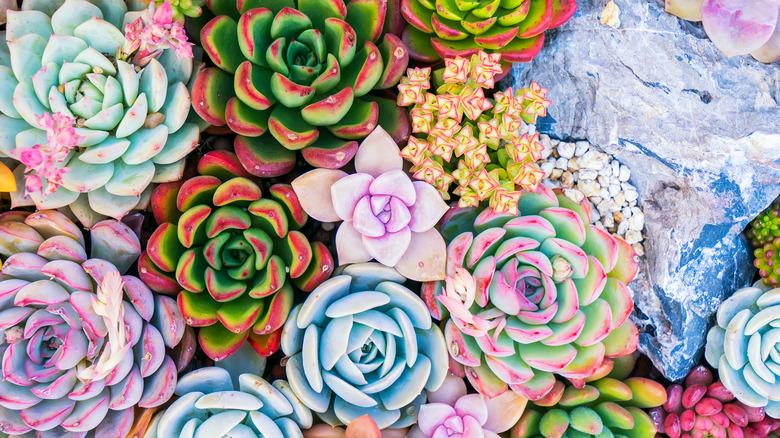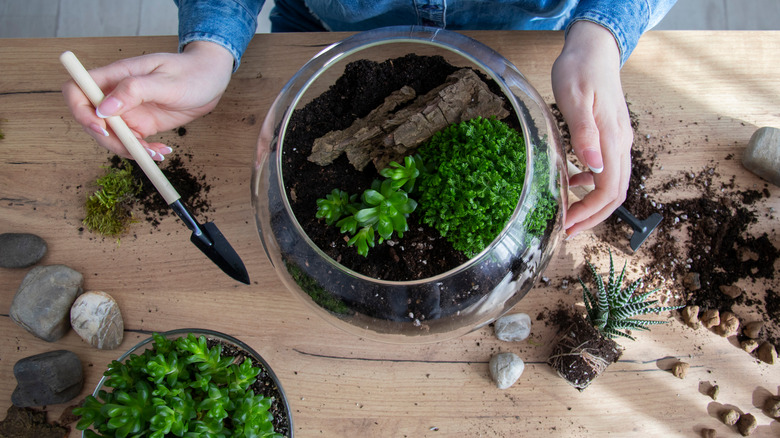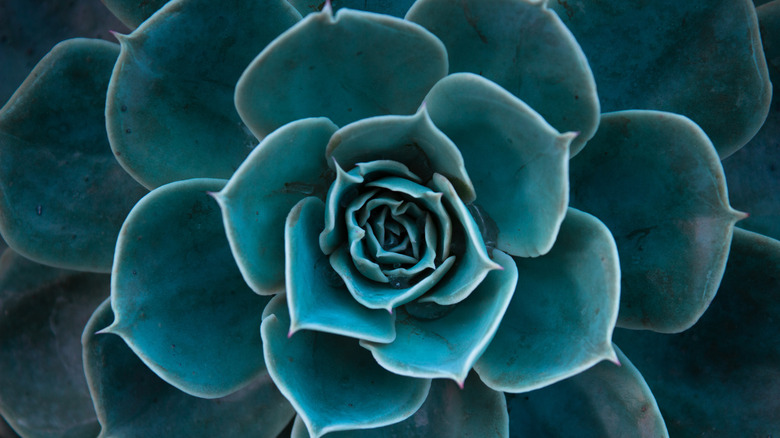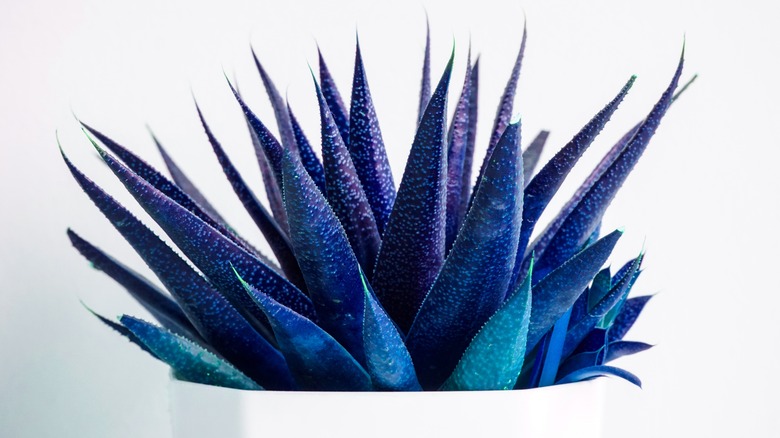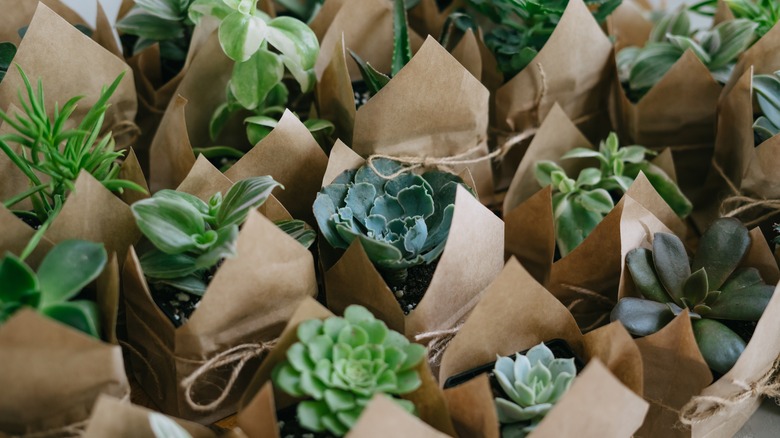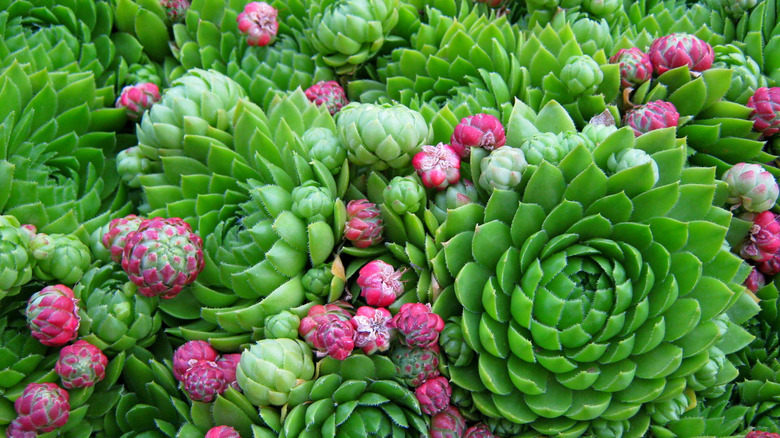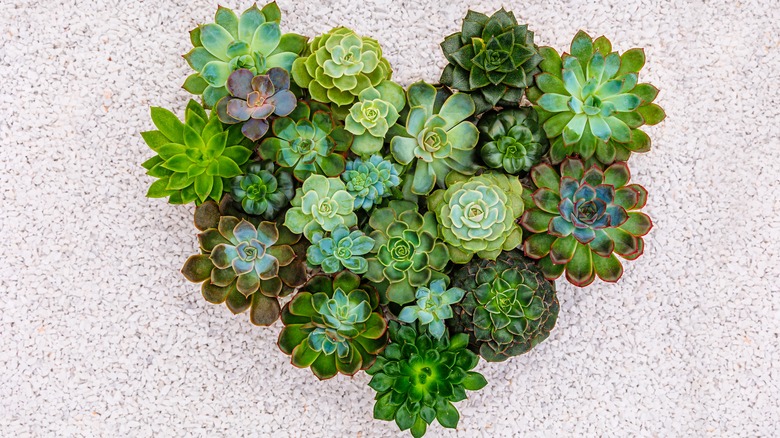How To Grow And Care For Succulent Cuttings
Succulents are a popular indoor and outdoor addition to any home. They exist in great abundance in their natural environment and can be found across all corners of the world (and in more than 10,000 unique species), according to the University of Florida's Institute of Food and Agricultural Sciences Extension.
Homeowners, apartment renters, and casual growers all foster a love for their easy-to-care-for foliage. In addition, succulents can be found in a wave of different colors and textures, and they are immensely difficult to kill off, making for a great pop of color in any home that requires little maintenance to keep healthy. As one author stated on Medium, succulents are able to survive and even thrive in nearly any natural environment while slotting in perfectly on an interior windowsill, home office desk, or exterior garden bed.
What's more, propagating new succulent additions to your collection is actually quite simple. Many succulents are avid growers and will quickly form new roots and trunk structures after simply falling off the main plant (via Succulents and Sunshine). From the collection of initial samples to taking cuttings of your own to spread out your succulent garden, the journey to include more of these beautifying and low-maintenance plants in your home life is a fascinating and rewarding one.
How to use succulent cuttings in garden
Succulents make a great addition to either an indoor plant collection or an outdoor garden. The University of Illinois Urbana-Champaign Extension reports that succulents have experienced a meteoric rise in popularity since 2007. These plants are easy to care for and can be found in abundance commercially. The Extension also reports that the most likely cause of death for a succulent is overwatering, making it a particularly hardy plant that won't bring a sense of failure into the equation that often dissuades homeowners from continuing in their agricultural pursuits.
Garden Design suggests that succulents offer a versatile option that can fit into any number of environments. Surprisingly, the key element for success when planting succulents is neglect. They thrive in an outdoor rock garden that makes use of sandy soil and can be equally successful when planted in small containers that will live indoors. Adding succulents to indoor planters is a great option for those who want the ability to continuously rearrange their plant display.
Mixing different colors and textures is another great way to make the most of your succulent collection. They can be planted together in a large container or individually in separate vessels with equal measures of success. The options for arranging a collection of succulents are endless. One thing to note, however, is the need for sunlight overexposure protection. Succulent Plant Care recommends just four to six hours of sun daily.
How to grow succulent cuttings
One of the easiest ways to grow succulents is through the use of cuttings. Taking cuttings is a natural part of cultivating new plant life across many different species (via The Spruce).
Succulents and Sunshine list a number of easy to propagate succulents that do very well when grown from cuttings, with the Ghost Plant (Graptopetalum paraguayenese), Jelly Bean Succulent (Sedum rubrotinctum), and Burro's Tail (Sedum morganianum) all offering a combination of easy propagation and spectacular plant growth that's sure to wow. For instance, the Burro's Tail will regrow from even the smallest leafy cutting while the Ghost Plant provides a unique pale greenish-red tint to external planting spaces.
Gardener's Path recommends using one of a few tried and true propagation methods when replanting new succulents from cuttings or from simple root division. Many succulent varieties will create natural offshoots that grow miniature plants alongside the main stem. In this case, uprooting the smaller plant and moving it to a more suitable location is all it will take to grow a new succulent. Others can be divided through root separation: Digging up the existing succulent and carefully cutting the route into new sections will allow you to propagate a series of new plants. Yet, perhaps the easiest approach to taking cuttings is simply removing and replanting whole leaves from the growing plant.
How to care for succulent cuttings
Because succulents require such minimal care — unlike other plant cuttings that need water or soil contact, simply allowing the cut leaf time will give it the opportunity to root and grow into an entirely new plant. When dealing with the cuttings, simply letting them rest and breathe will allow them to propagate a new plant. Gardener's Path estimated that it typically takes a few weeks for roots to begin growing from a standard succulent cutting. Once rooting has begun, encouraging growth is as simple as planting the new succulent in well-draining soil and treating it as you would any other succulent in your collection.
For an existing succulent, south- or west-facing windows provide the best location for its sunlight requirements, which will help the plant maintain its overall health while ensuring adequate shade (via the University of Illinois Extension). The primary components of success in caring for a succulent lie in the combination of sun and shade that you provide the plant. Planting them in a spot in the garden that enjoys shifting sun coverage (perhaps with a purpose-built mesh or other shadings) will protect your succulents in the long term.
Popular succulent cutting varieties
Succulents come in a huge number of different varieties. But there are some perennial favorites among succulent growers. Among the more than 10,000 varieties that occur in nature (via the University of Florida's Extension), these are some of the most commonly used.
- The Burro's Tail (Sedum morganianum) is a must-have addition to any succulent gardener's collection. It's one of the easiest to care for and take cuttings from and grows well in indoor areas.
- The Ball Cactus (Parodia magnifica) represents a more traditional cactus look and will burst into flowering blooms during the warmer months (via Just Houseplants).
- The African Baobab (Adansonia digitata) is a unique addition to any succulent garden. It grows upwards, resembling a set of roots, and can reach massive heights of nearly 100 feet tall if left to its own devices (over the course of many years), according to Succulent City.
- Leafy Place reports that the Flaming Katy (Kalanchoe blossfeldiana) produces small, dark green leaves and flowers throughout the fall with an array of bright pink blossoms.
- The Jade Plant (Crassula ovata) is a favorite among succulent collectors, according to Better Homes & Gardens. This one is listed among the site's easiest succulent varieties for beginners just getting into the craze.
Are succulent cuttings toxic?
Succulent Plant Care reports that the vast majority of succulent varieties are non-toxic and are therefore safe to include in a garden that is shared by a house pet or a young child. However, Succulent Plant Care also noted that there are a few varietals that can induce skin irritation or slight intestinal discomfort when eaten. Aloe vera, for instance, should be strongly avoided in the home or gardens if you own a dog or cat.
The Crown of Thorns (Euphorbia Milii) is another succulent variety that can irritate the skin and cause nausea and related symptoms if ingested. This plant also grows striking red flowers and long thorns, making it similar to the rose in a distinctive way. The thorns can create their own set of issues for those with pets and children, whereas the plant itself is very bitter to the taste, making accidental poisoning an unlikely prospect.
How to repot succulent cuttings
There will come a time when you'll need to repot your succulent cuttings. The first thing to remember when replanting a succulent in a new pot is to be careful of the root system while ensuring that you don't get pricked by any spines or thorns that exist on the plant (via Leaf & Clay).
It's important to use cactus or succulent specific potting soil for any repotting you'll be doing. These soil mixtures are specifically designed to shed excess water and protect the roots, stem, and leaves from rotting as a result of soakage. Initially, remove any soil that comes from the pot and is tangled up in the roots as you prepare to place the succulent in its new home. This is important as the old soil will lack primary nutrients that are required for the plant to thrive. Flourishing Plants also suggested that salt buildup in the soil around the roots can lead to transplant shock. Carefully brushing away the leftover soil that comes out of the pot with your hand or a specialized root brush is all you'll need to do to prepare the plant for a new container.
When replanting your succulents, fill up the pot to about 3/4 full and then carefully set the plant into the pot. Fill in the rest of the space while taking care to keep a separation between the leaves and dirt to finish the repotting process.
Using fertilizer with succulent cuttings
While a succulent might not require extensive or regular watering, the use of fertilizers to help support healthy growth throughout the life of the plant is a good idea. Sublime Succulents recommends a plant food that uses a high percentage of phosphorous. In addition, Sublime Succulents notes that succulents are a unique kind of plant that grows and utilizes soil nutrients much slower than others. This means that a half dose of typical fertilizer that isn't formulated specifically for use in succulent gardens will do the job.
Succulents and Sunshine report that manure tea is another great option as a succulent-specific fertilizer. This type of fertilizer is made with a specialized tea bag of nutrient-rich manure that is steeped in a bucket of water over the course of a few days. Once the liquid fertilizer is ready for use, simply applying the liquid directly to your succulent will provide all the nutrients the plant needs. Succulents and Sunshine claim that these fertilizer alternatives are much milder than traditional additives and will give your succulent garden the boost it needs without over-saturating the plants and risking damage.
